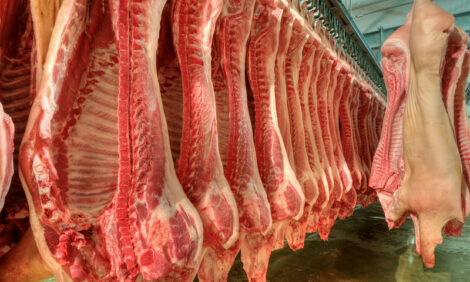



Market Preview: Economic Uncertainty Spills Over All
US - Weekly US Market Preview provided by Steve R. Meyer, Ph.D., Paragon Economics, Inc.The uncertainty in credit markets continues to play havoc with financial and commodity markets as the House of Representatives takes up a $700 billion stimulus package that seeks to put a floor under mortgage-backed securities and kick start capital flows. The uncertainty of whether the U.S. government will actually step into these markets has likely made the situation worse this week.
Major stock indexes were down sharply again on Thursday and several meat and poultry companies have taken some significant hits this week. Worst among them is Pilgrim's Pride, the nation's largest chicken producer, which has seen its stock price fall from just over $25/share on June 2 to just $3.01 on Thursday - and that's up 25% from its all-time low of $2.49 on Tuesday. Smithfield Foods and Tyson also saw their stock prices tumble in recent trading sessions.
Smithfield has been a highly leveraged company for some time and the prospect of reducing that leverage position was one of the drivers, or at least one of the benefits, of Smithfield's sale of its beef assets to JBS Swift last year. The trouble is that the Department of Justice has still not cleared that deal on anti-trust grounds, so it has not been closed and Smithfield still does not have the cash in hand. Smithfield released a statement earlier this week reiterating that its credit arrangements and financing facilities were sufficient to carry it through these difficult times. Smithfield's stock closed Thursday at $16.57, down $1.14 for the day. It traded as high at $31.78 as recently as May 30.
Tyson's stock has fallen from about $17/share in mid-August to $12.30, down $0.57/share on Thursday. The stock had reached its 52-week high of $19.50 on April 21. Its biggest problems are in the chicken business as both pork and beef packing have realized good margins this summer. Tyson did get a bit of good news on Thursday when Standard and Poor's raised its bond ratings back to investment grade. Tyson's bonds had been downgraded to junk status last month.
Market Vibes Nick Commodities, Too
The more important facet of this situation for hog producers is that the negative vibes have spilled over to commodities. This is a “half full” or “half empty” situation, as both costs and revenues have been hit.
See Figures 1 and 2 for weekly nearby corn and soybean meal futures prices. These charts, as well as the daily charts, have seen some major technical damage this week with some long-standing support levels penetrated.


December corn, at $4.54, is within reach of a support line at the top of the 2006-07 trading range at $4.37 and a chart gap from last December that extends to $4.22. I would not be surprised to see that gap covered, given current market psychology.
December soybean meal has penetrated three separate support lines this week and is just $16/ton away from another support line established as a resistance level in July 2007. Should that support be penetrated, the next objective would be former resistance at $202. I can hardly believe I am writing these numbers.
And what has the impact been on feed costs? Figure 3 shows my feed price index has dropped to $169 to $188/ton from now through the end of 2009, fully $100/ton lower than it was on July 1. Those feed prices mean that breakeven costs for Q4 will be in the $73-$78/cwt., carcass range, according to the production parameters used by Iowa State in its Estimated Costs and Returns series. Costs for 2009 would be from $71 to $74/cwt., carcass, if producers locked in Thursday's futures prices and bases were at historical levels. That's a far cry from the $94 to $96 we were seeing back in July.

But the market giveth and the market taketh away. Every Chicago Mercantile Exchange (CME) Group Lean Hogs contract except October made new life-of-contract lows this week, with most of them $16-$18/cwt., carcass, below their July high. And I don't think the sell-off had anything to do with last Friday's Hogs and Pigs Report. It is virtually all the result of market psychology and demand concerns fueled by the financial and credit market situations.

There is some well-founded concern about meat demand in the wake of this much wealth destruction. Many are also concerned about international markets, which are feeling some pain from the U.S. crisis as well. I cannot tell you how this is going to come out, whether Congress acts or not.
So, we do what seems prudent. With hogs nearing $20 from their contract highs, I am tempted to take my chances with cash markets, especially for April and beyond. If your financial position is weak, you may need to bite the bullet and lock in losses in order to remove the possibility of larger losses. If your position is stronger, cash market risk may be worth taking.
Feed-Buying Opportunity
Regardless of your thoughts on hogs, I have to believe this is a feed buying opportunity, the magnitude of which I never thought we would see this year. Let these contracts show signs of a bottom and add to your feed coverage. There will be no more corn made for this crop year and there will be no more soybeans made until April in South America.
Demand may be suspect, but the Renewable Fuel Standard is still in effect (10.5 billion gallons of ethanol next year, using at least 3.75 billion bushels of corn – and USDA says 4.1 billion bushels and ethanol plant usage capacity next year will be more like 4.8 billion bushels), and the U.S. treasury is still allowing blenders to deduct $0.46/gal. from their taxes. Demand may slow, but it will not disappear.









